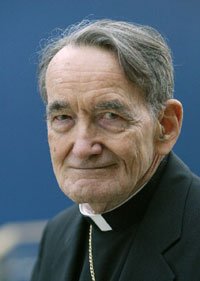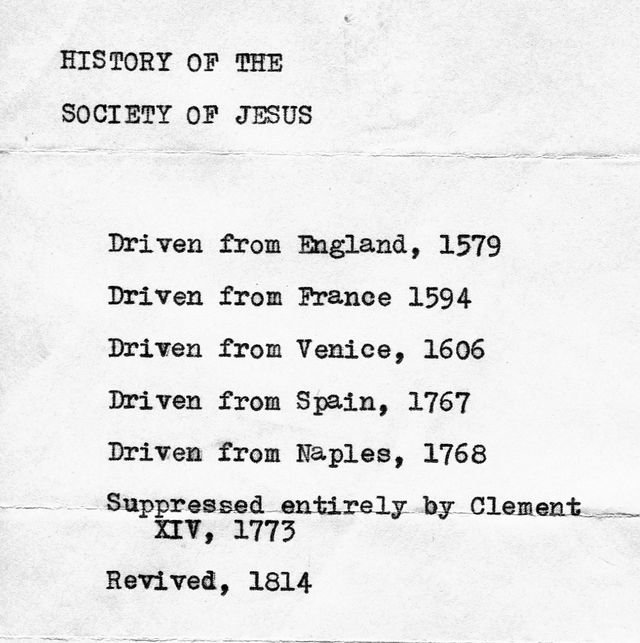Society of Jesus: Difference between revisions
Jump to navigation
Jump to search
m (Text replacement - "--" to " — ") |
|||
| (8 intermediate revisions by the same user not shown) | |||
| Line 16: | Line 16: | ||
|align="right"|''varies'' | |align="right"|''varies'' | ||
|Applicant | |Applicant | ||
|The process of "formation" | |The process of "formation" — being trained to be a Jesuit — begins with the dialogue between the Society and a candidate. No one can enter the Society unless they have some understanding of what it means to be a Jesuit. | ||
|- valign="top" | |- valign="top" | ||
|align="right"|8 days | |align="right"|8 days | ||
| Line 54: | Line 54: | ||
: '''Professed father''': solemn vows of poverty, chastity, obedience, and availability to be given a mission by the Pope. The professed are the inner core of the Society. They alone have all rights and privileges of membership. Everyone else is in a lower level of the Jesuit hierarchy. | : '''Professed father''': solemn vows of poverty, chastity, obedience, and availability to be given a mission by the Pope. The professed are the inner core of the Society. They alone have all rights and privileges of membership. Everyone else is in a lower level of the Jesuit hierarchy. | ||
|} | |} | ||
== St. Edmund Campion == | |||
:: And touching our Society, be it known to you that we have made a league — all the Jesuits in the world, whose succession and multitude must overreach all the practice of England — cheerfully to carry the cross you shall lay upon us, and never to despair your recovery, while we have a man left to enjoy your Tyburn, or to be racked with your torments, or consumed with your prisons. The expense is reckoned, the enterprise is begun; it is of God; it cannot be withstood. So the faith was planted: So it must be restored. | |||
== Suppression (1773-1814) == | |||
I typed this out from the ''New Yorker'' in 1974-1975. | |||
[[File:History of the society.jpg|640px]] | |||
== References == | == References == | ||
| Line 62: | Line 72: | ||
[[File:Dulles200.jpg|thumb|<div align="center">[http://averydulles.blogspot.com/ Avery Dulles Archive.]</div>]] | [[File:Dulles200.jpg|thumb|<div align="center">[http://averydulles.blogspot.com/ Avery Dulles Archive.]</div>]] | ||
* [http://www.ignatius.com/Products/SESI-M/spiritual-exercises-of-st-ignatius.aspx "Spiritual Exercises of St. Ignatius" (DVD).] 13 talks designed for people to do the Spiritual Exercises at home (known among Jesuits as a "Nineteenth Annotation Retreat." | * [http://www.ignatius.com/Products/SESI-M/spiritual-exercises-of-st-ignatius.aspx "Spiritual Exercises of St. Ignatius" (DVD).] 13 talks designed for people to do the Spiritual Exercises at home (known among Jesuits as a "Nineteenth Annotation Retreat." | ||
* [http://www.con-spiration.de/syre/english/aug/e0826.html James Brodrick, SJ,] [http://www.ignatius.com/Products/SIL-P/st-ignatius-of-loyola.aspx ''St. Ignatius of Loyola: The Pilgrim Years.''] From age 30 to 47: "Seventeen years of endless and often very moving trials" (1521 to 1538 | * [http://www.con-spiration.de/syre/english/aug/e0826.html James Brodrick, SJ,] [http://www.ignatius.com/Products/SIL-P/st-ignatius-of-loyola.aspx ''St. Ignatius of Loyola: The Pilgrim Years.''] From age 30 to 47: "Seventeen years of endless and often very moving trials" (1521 to 1538 — Pamplona to Rome). | ||
:: | :: — — — . [http://www.amazon.com/Origin-Jesuits-James-Brodrick/dp/0829409300 ''The Origin of the Jesuits.''] (Recommended by Magdeline from Williamsville, but we didn't get it on the air last week.) | ||
* Joseph N. Tylenda, S.J., [http://www.ignatius.com/Products/PILJ-P/a-pilgrims-journey.aspx ''A Pilgrim's Journey: The Autobiography of St. Ignatius of Loyola.''] | * Joseph N. Tylenda, S.J., [http://www.ignatius.com/Products/PILJ-P/a-pilgrims-journey.aspx ''A Pilgrim's Journey: The Autobiography of St. Ignatius of Loyola.''] | ||
:: | :: — — — . [http://woodstock.georgetown.edu/ignatius/letters.htm ''Selected Writings of St. Ignatius of Loyola.''] | ||
* Andre Ravier, S.J., [http://www.ignatius.com/Products/DIHR-P/do-it-at-home-retreat.aspx ''Do It at Home Retreat: The Spiritual Exercises of St. Ignatius.''] | * Andre Ravier, S.J., [http://www.ignatius.com/Products/DIHR-P/do-it-at-home-retreat.aspx ''Do It at Home Retreat: The Spiritual Exercises of St. Ignatius.''] | ||
* William Bangert, S.J., [http://www.ignatius.com/Products/TOT-P/to-the-other-towns.aspx To the Other Towns: The Life of Blessed Peter Favre, First Companion of St. Ignatius.] | * William Bangert, S.J., [http://www.ignatius.com/Products/TOT-P/to-the-other-towns.aspx To the Other Towns: The Life of Blessed Peter Favre, First Companion of St. Ignatius.] | ||
| Line 74: | Line 84: | ||
[[Category:Discernment of Spirits]] | [[Category:Discernment of Spirits]] | ||
[[Category:Spirituality]] | [[Category:Spirituality]] | ||
[[Category:Field Guide]] | |||
Latest revision as of 12:18, 10 December 2022
Some contemporary Jesuits
Mitch Pacwa, SJ
Robert Spitzer, SJ
Joseph W. Koterski and John J. Conley have a collection of essays on the thought of John Paul II.
James V. Schall is very orthodox: "What is Roman Catholic Political Philosophy?"
Course of Studies
It takes roughly twelve years, at a minimum, to complete the process of becoming a Jesuit. Formation begins with the first inquiries about joining the Society and ends with taking final vows after tertianship.
| varies | Applicant | The process of "formation" — being trained to be a Jesuit — begins with the dialogue between the Society and a candidate. No one can enter the Society unless they have some understanding of what it means to be a Jesuit. |
| 8 days | Postulant | I'm not sure whether this is still officially a part of our formation. No distinction was made when I entered the novitiate. But it is important to know about this stage because it was the 'first probation.' This is what gives tertianship its special meaning as "third probation." |
| 2 years | Novice | "Second period of probation." The novitiate ends with taking simple vows of poverty, chastity, and obedience to our religious superiors, along with a promise to enter the Society of Jesus if we are allowed to do so at the end of our formation. These simple vows make a man something like an indentured servant. He cannot free himself, but the Society can let him go without a solemn canonical process. |
| 2 years | Philosopher | |
| 3 years | Regent | |
| 4 years | Seminarian | |
| varies | Priest |
|
| 1 year | Tertian | "Third period of probation." Completion of tertianship leads to final vows that are either simple or solemn. |
|
"Fully Formed Father" |
|
St. Edmund Campion
- And touching our Society, be it known to you that we have made a league — all the Jesuits in the world, whose succession and multitude must overreach all the practice of England — cheerfully to carry the cross you shall lay upon us, and never to despair your recovery, while we have a man left to enjoy your Tyburn, or to be racked with your torments, or consumed with your prisons. The expense is reckoned, the enterprise is begun; it is of God; it cannot be withstood. So the faith was planted: So it must be restored.
Suppression (1773-1814)
I typed this out from the New Yorker in 1974-1975.
References
Links

- "Spiritual Exercises of St. Ignatius" (DVD). 13 talks designed for people to do the Spiritual Exercises at home (known among Jesuits as a "Nineteenth Annotation Retreat."
- James Brodrick, SJ, St. Ignatius of Loyola: The Pilgrim Years. From age 30 to 47: "Seventeen years of endless and often very moving trials" (1521 to 1538 — Pamplona to Rome).
- — — — . The Origin of the Jesuits. (Recommended by Magdeline from Williamsville, but we didn't get it on the air last week.)
- Joseph N. Tylenda, S.J., A Pilgrim's Journey: The Autobiography of St. Ignatius of Loyola.
- Andre Ravier, S.J., Do It at Home Retreat: The Spiritual Exercises of St. Ignatius.
- William Bangert, S.J., To the Other Towns: The Life of Blessed Peter Favre, First Companion of St. Ignatius.
- Patrick W. Carey, Avery Cardinal Dulles, S.J.
- For the Jesuit saints who lived up to the ideals of St. Ignatius, see books about Peter Canisius and Robert Cardinal Bellarmine, both of whom are doctors of the Church.
